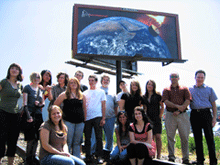Community-Based Teaching Program
The Community-Based Teaching Program (CBTP) serves as a source of engagement and dialogue among Easton’s burgeoning artist population, the College, and the local community.
 The program is divided into two components: The Lafayette Experience—an accredited course for select area high school students led by Jim Toia, the program’s director—and a weekly supervised workshop session available to all Easton and local area residents. Using the award-winning design studio facilities of the Williams Visual Arts Building, Lafayette fosters artistic growth and development in the Easton community.
The program is divided into two components: The Lafayette Experience—an accredited course for select area high school students led by Jim Toia, the program’s director—and a weekly supervised workshop session available to all Easton and local area residents. Using the award-winning design studio facilities of the Williams Visual Arts Building, Lafayette fosters artistic growth and development in the Easton community.
CBTP works closely with Easton, Phillipsburg, and Belvedere high schools to offer an interactive program that helps students learn the many languages of art and build a strong art portfolio. Each year, after a vigorous selection process within their respective high schools, about 20 students enroll in the course. Through a stringent array of assignments and conceptual challenges, students are pushed to develop analytical thinking and problem-solving in the visual arts. Recently, our high school students engaged with St. Luke’s Hospital at their Easton Campus to design a new lobby space and interior mural intended to bring a more peaceful and meditative environment to their second-floor visitors center. This 36′ long mural included imagery, text, and glass panels designed and painted by our students after 6 months of workshops and proposals with hospital staff and designers, doctors. and nurses.
 In addition, visiting artists often speak on the visual arts and their respective fields. In recent years, the Community-Based Teaching Program has hosted such notable guest lecturers as conceptual artist Glenn Ligon, sculptor Willie Cole, and painter Darina Karpov.
In addition, visiting artists often speak on the visual arts and their respective fields. In recent years, the Community-Based Teaching Program has hosted such notable guest lecturers as conceptual artist Glenn Ligon, sculptor Willie Cole, and painter Darina Karpov.
On Thursday evenings, a live model session is open to the public from 6:00-9:00 PM, free of charge.
The benefits and learning opportunities through the Community-Based Teaching Program extend to Lafayette art students, who participate as teaching assistants. This is a valuable, first-hand teaching experience rarely found at an undergraduate institution. These students are encouraged to develop class projects for the high school program, and they may gain additional access to visiting artists.